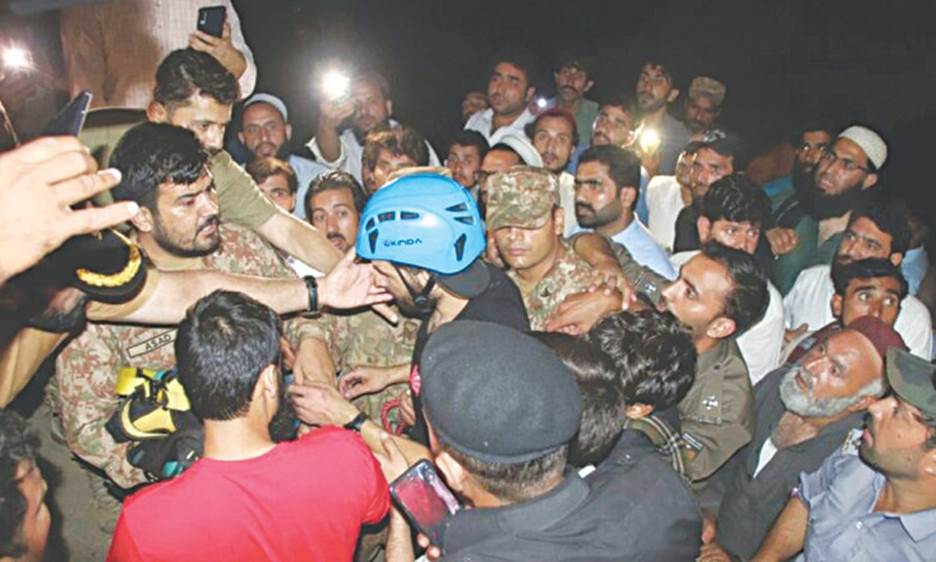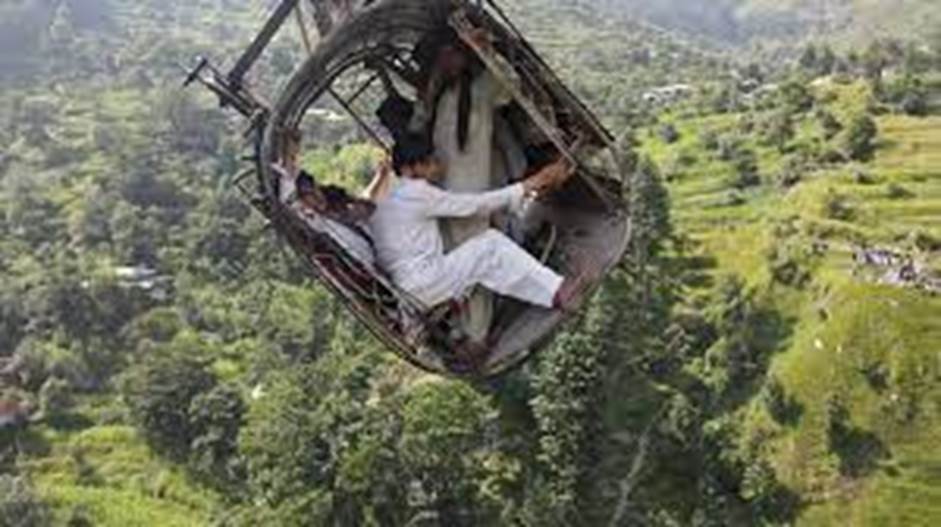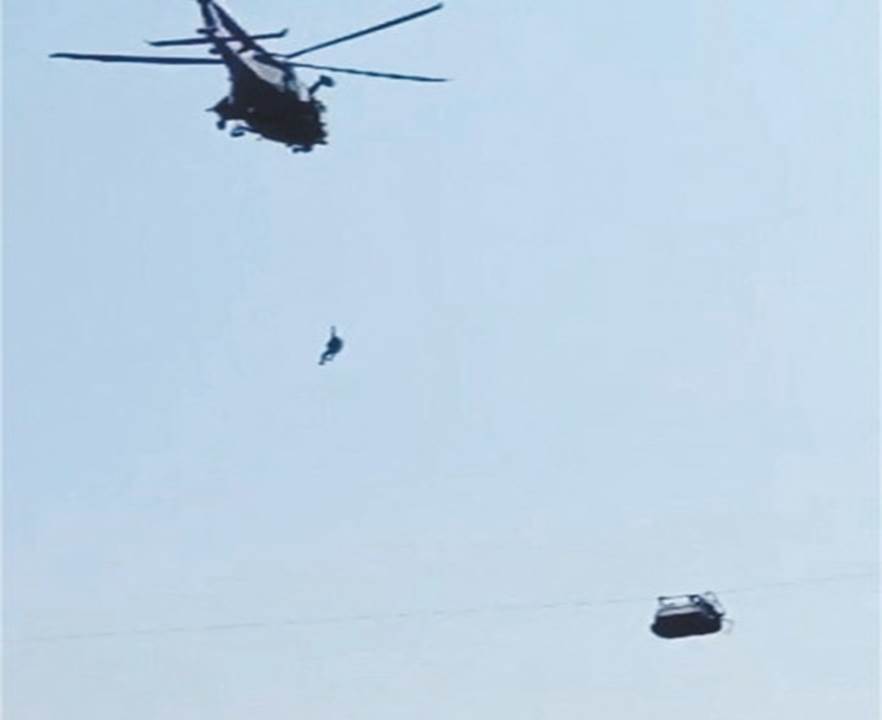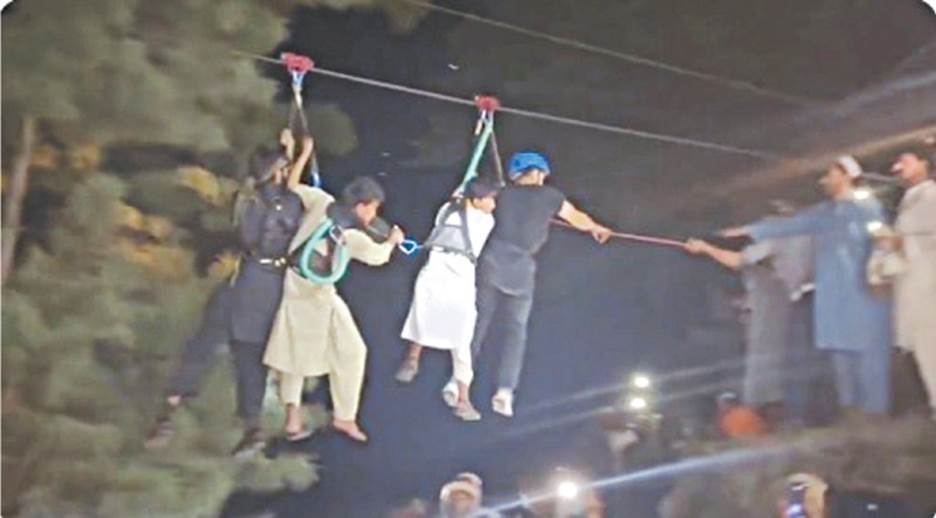
Army troops and locals assisted in the ground rescue mission which was successful in retrieving the remaining six passengers stuck in the cable car for 14 hours | EFE
What Really Happened iIn Allai?
By Hamayoun Baber
More than a fortnight after the day-long, dramatic rescue of passengers inside a dangling cable car in Allai tehsil in Khyber-Pakhtunkhwa’s Battagram district, disinformation as well as some confusion about the nature of the recovery operation continues.
Locals say they are accustomed to cable cars getting stuck, but what was unusual was how long this operation took and have expressed resentment towards the administration for letting it go on that long, and for letting it become an international story.
Local resident Niamat Ullah Khaksar, for example, says the rescue could have been wound up in two or three hours but, instead, the government prolonged the rescue operation for up to 15 hours. Others say locals did not have the necessary equipment to carry out such a rescue and whatever efforts they made could have led to fatalities.
Does the truth lie somewhere in between? Does it matter, since the passengers aboard were all safely rescued?
Dangling in the air
The passengers stuck in the cable car began their day like any other day that Tuesday morning, as they waited to use the cable car to cross the river from one mountain to another. These cable cars are the only form of commuting for local residents to transport goods, construction materials or to get to their destinations, such as schools.
There is no form of regulation to ensure safety standards have been met for these makeshift cable car systems. According to locals, there have been incidents in the past, where wires have snapped and people, as well as animals, have fallen to their death into the ravines.
One local resident, Haleem Khan, narrates an accident during the Eid holidays in 1994, when 13 women and children, who were using a cable car in Kotgalla village in Battagram, fell when its pulley “went out of control.” The cable car crashed into the safety wall of a parking area and all but a five-month-old baby died.
He also narrates another incident from before the 2005 earthquake and says that, despite these accidents, people did not stop using cable cars. They have no other option.

The passengers on the eventful day heard a wire snap and were flung on to the side of the cable car as it dangled from the remaining cable
Many of the passengers — most were young boys going to school — stuck inside that cable car on August 22 have since told the press about hearing a wire snap, being flung on to the side of the cable car as it dangled from the remaining cable and about their fears of falling to their death at any moment. Their families, meanwhile, watched scenes unfold from the ground, unsure if they’d see their loved ones again.
In and on the air
When the news of the accident reached Battagram’s local administration, deputy commissioner Tanveerur Rehman sent a letter to the commissioner Hazara, requesting an aerial rescue operation. He felt this was the safest method.
The commissioner Hazara, upon receiving this letter, then asked the chairman of the National Disaster Management Authority (NDMA), the secretary of the Relief Rehabilitation and Settlement Department and the director general of the Provincial Disaster Management Authority (PDMA) to provide a helicopter for the rescue mission.
A helicopter reached the site and surveyed the area to assess how a rescue operation could be conducted. The pilot then flew back and returned with two other helicopters, one from the air force and the other from the army. Most of their rescue attempts were being played out on national TV by this point.
Audiences across the nation could see the helicopter pilot was finding it difficult to access the cable car because of one of the wires atop the cabin and, when he attempted to get close to the cabin, it would dangle like a pendulum because of the downwash from the chopper blades.
A military commando suspended from the helicopter was able to give passengers some biscuits and water and the chopper crew was successful in rescuing one student using a rope to bring him up. However, a second attempt failed because the rope got stuck in one of the cable car’s wires. The chopper crew had to cut the rope loose and suspend their operation. A decision was made to attempt a ground operation.
On the ground
As soon as news of the cable car incident spread, locals contacted Sahib Khan, known for his rescue operations, and sent a car for him and his team in the Shang Besham area of district Shangla. Khan is a third generation ‘mandgan’, a local word used to describe sailors and divers, who are called to save and retrieve bodies from the river. They also have years of experience in the installation of cable cars as well as rescue operations, with a good track record, Sahib says.
Sahib arrived in Allai tehsil by noon but was stopped from carrying out the rescue operation by the administration, which said it was too risky. He and his team watched from the ground, frustrated that they were unable to help.
However, Sahib went against orders and used some of his equipment as well as some from Rescue 1122 to retrieve one child, Niaz Muhammad. However, he was disallowed by the local administration from going again.
By this point, two of the cable car passengers had been rescued.
While locals had called for Sahib Khan to help with the rescue, the deputy commissioner of Mansehra contacted Heavens Way to assist. It is essentially a zip line company which offers adventure tours across KP and Islamabad.
According to the company’s executive director, Muhammad Zahid Hunzavi, Pakistan army’s helicopter picked up his team from Thakra stadium in Mansehra and flew them to the rescue site. His team of Muhammad Ali Swati and Muhammad Ilyas, along with others, were successful in rescuing the remaining six on board.

The dramatic rescue mission of students stuck in a chairlift in Khyber Pakhtunkhwa gripped the nation on August 23. The helicopter was able to rescue one student before it had to suspend operations. The remaining passengers were rescued by ziplines | AFP
Swati led the operation. By the time he and his team arrived at 6:30pm, he says everyone from local administration officials, health officials, army troops and a team from Rescue 1122 was there. He first let them all know that his team was properly equipped to carry out this mission.
At this point, another local rescuer was attempting to get a passenger using a charpai pulley but had to return, as he couldn’t move further because of the gusting winds. This attempt, according to Swati, resulted in an hour’s loss because, by the time he and his team began, it was 8pm.
“If we could have started in natural light, we could have completed it in one hour,” he says.
Swati says they set up their equipment and, when they reached the dangling cabin, they found not six but seven occupants — “one was a local rescuer who had come from the other side with “juggaarr” [makeshift] equipment and was himself now stuck,” says Swati.
“We told him to return somehow as he was unable to understand the techniques we planned to use to rescue the passengers,” says Swati.
That man was, in fact, Sahib Khan, who had stayed on in the cabin following the first rescue. He disputes Swati’s claim that he was stuck, saying that his strategy of rescuing differs from Heavens Way and that he stays in the cabin until everyone has been rescued. Heavens Way leaves passengers in the cabin and returns when they’ve dropped the first lot off, he claims.
He says he even assisted the Heavens Way team during the rescue by shining his mobile torch on the passengers being tied to ropes while the Heavens Way rescuers filmed the video.

The Heavens Way team’s zipline helped in retrieving the stuck passengers| Video screengrab
Sahib also says that once the Heavens Way rescuers left with the last three passengers, they did not return for him. He ended up being rescued by his cousin, Hassanzeb, who had accompanied him to Allai tehsil that morning and had assisted in the retrieval of the student Niaz Muhammad.
Sahib says that while the main rescue mission ended around 10:30pm, his own retrieval took till 1:30am.
Who did it better?
Given that locals and Heavens Way had the same rescue strategy, i.e., to get to the cable car on zip lines, but access to different tools, and each had different levels of success, why did it seem like a bone of contention between the two parties? Why have there been efforts to portray one as good or bad or discredit their efforts?
Swati says it was because locals were “busy trying to outdo each other” in wanting to participate in the mission themselves and, as a result, adding a lot of load on the wires.
“If 10 or 15 got on the wire, it would have caused a lot of nuqsaan [loss] and the cabin could have fallen,” says Swati. This was why he and his team had told the administration to halt any rescue efforts until their arrival, as the company had the proper equipment.
“We weren’t looking to be heroes,” he explains. “We were doing it to save lives.” He says the local administration and the army helped calm locals’ nerves, explaining that everyone’s intent was to save lives.
He adds that he doesn’t begrudge anyone and understands everyone’s panic and fear at that time. Swati also explains how, in the end, the rescue effort was a collective one, as many people assisted him in the rescue.
For example, as he got on the wires at nighttime, and telecom was down, he had to communicate using a flashlight. “I told them they had to watch for the light signal and pull [the ropes]. Because the gradient was up, I could not use my hands, so was reliant on everyone to pull me and the passengers back to safety.”
Swati was exhausted by the time he arrived back with the first three passengers in an operation that took one-and-a-half hours because, at one point, one of the rescue ropes got stuck. As he had understood the challenges of the mission — no communication, gusty winds and the physical exertion of the task — he knew he could not go again. So, he explained the strategy to the SSG (Special Services Group) commandos to go with Ilyas to rescue the remaining passengers.
By this time, wireless communication was up so the operation was smoother, as locals were able to follow instructions on the transmitters and pull the rope.
So, it was proper equipment coupled with the assistance of everyone on the ground that helped his mission succeed. He says it could have happened sooner had he not spent an hour-and-a-half convincing locals that he was qualified for the task. He is adamant that the army did not call for his services but were told about his abilities by the DC Mansehra, so they did not need convincing like the locals did.
“The people who initially created the hurdles ended up helping me in the end,” he says.
Disinformation and Accountability
Although the rescue mission proved to be a collective effort, it did not come across that way. Many on social media tried to make it as “locals vs the military”, saying the army was using the opportunity to “improve” its image following accusations of political meddling. This correspondent did hear similar sentiments on the ground that day that locals were being prevented by the army from launching a rescue because it wanted to take credit for the operation.
As for the accountability process, almost everyone in the area agrees nothing will come of it, though two men — the cable car owner and its operator — have been arrested for negligence.
Whenever such incidents happen, the administration and government issue strict warnings to the cable car operators to ensure safety arrangements and install equipment with technical assistance from qualified persons or institutions. But it seems, as time passes, the administration loses interest in regulating these cable cars.
This time as well, the caretaker government has issued strict warnings and asked action be taken against owners whose cable cars do not meet safety requirements. But given the history of such warnings, the same laxity is expected once again.
Many locals understand there are risks involved in using cable cars that have been shoddily assembled and do not adhere to any safety standards. But since there is no other form of transportation in these tough terrains filled with difficult uphill paths, they say the banning of cable cars is not a feasible option either.
A more realistic and sustainable approach is needed, they say, otherwise such incidents will continue to recur.
(The writer is Dawn’s correspondent in Battagram. Dawn)

